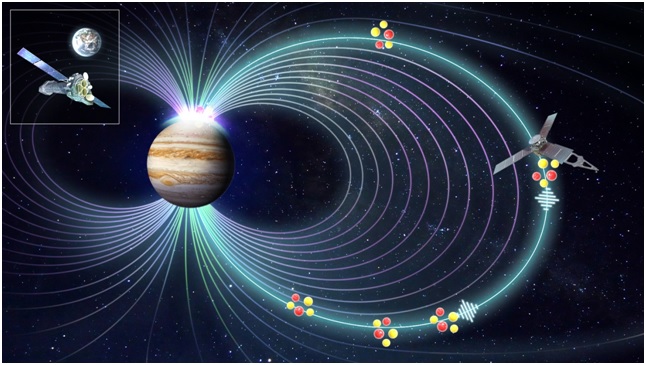
The NASA's Juno Mission observed pulsating electromagnetic ion cyclotron waves in Jupiter's dawn magnetosphere, which periodically expel the energetic heavy ions into the atmosphere, producing the stunning X-ray pulsations as captured by the ESA XMM-Newton(Image by YAO's group)
A research team, led by YAO Zhonghua from the Institute of Geology and Geophysics, Chinese Academy of Sciences, have finally uncovered the 40-year-old mystery of what causes Jupiter's X-ray auroras. It is the first time that planetary researchers have detected the entire causality chain for Jupiter's X-ray flares, which is believed to have potential applications to X-ray astronomy.
The X-ray auroral spectra tell us that they are produced by heavy ions with energies in the mega electron volts range. But how are they formed and why would these ions come to Jupiter's atmosphere was still unknown. By combining unique observations by ESA's flagship X-ray observatory, XMM-Newton, with NASA's Juno spacecraft we have been able to probe the physics responsible for the phenomenon, finally revealing the processes that lead planets to produce X-ray aurora.
These are strikingly similar to the processes for producing ion aurora at the Earth, suggesting that ion aurorae share common mechanisms across planetary systems, despite temporal, spatial and energetic scales varying by orders of magnitude, says YAO Zhonghua.
To understand the energetic processes associated with Jupiter's polar emissions, over the last 4 years a series of paradigm-shifting observing campaigns from Earth have been organized in tandem with in situ measurements by NASA's Juno spacecraft. These included the most extensive X-ray campaign (ESA XMM-Newton) for a planet (~2 mega seconds) and the most extensive Hubble Space Telescope campaign for a planet (~200 orbits).
"What we see in the Juno data is this beautiful chain of events. We see the compression happen, we see the EMIC wave triggered, we see the ions, and then we see a pulse of ions traveling along the field line. And then a few minutes later, XMM sees a burst of X-rays," says William Dunn, Mullard Space Science Laboratory, University College London, who co-led the research. The comprehensive X-ray dataset was from an XMM-Newton observing program, which was also led by William.
It is noteworthy that Jupiter's X-ray flares are often correlated with the ultraviolet auroral flares, which is the most common auroral form that we have in mind as a benefit of the wealthy dataset from the Hubble Space Telescope. "The discovery of Jupiter's X-ray processes may provide strong implications to our understandings of the stunning ultraviolet auroral flares", says Denis Grodent, Director of Space sciences, Technologies and Astrophysics Research (STAR) Institute, University of Liege, who co-authored on this research. The largest Hubble Space Telescope observing program for Jupiter (GO-14634) was led by Denis.
Scientific reference
'Revealing the source of Jupiter's x-ray auroral flares' by Z.H. Yao and W.R. Dunn et al. (2021) is published in Science Advances. DOI: 10.1126/sciadv.abf0851
Contact
YAO Zhonghua
Institute of Geology and Geophysics, Chinese Academy of Sciences, Beijing, China
Phone: +86-10-82998706
E-mail: z.yao@mail.iggcas.ac.cn